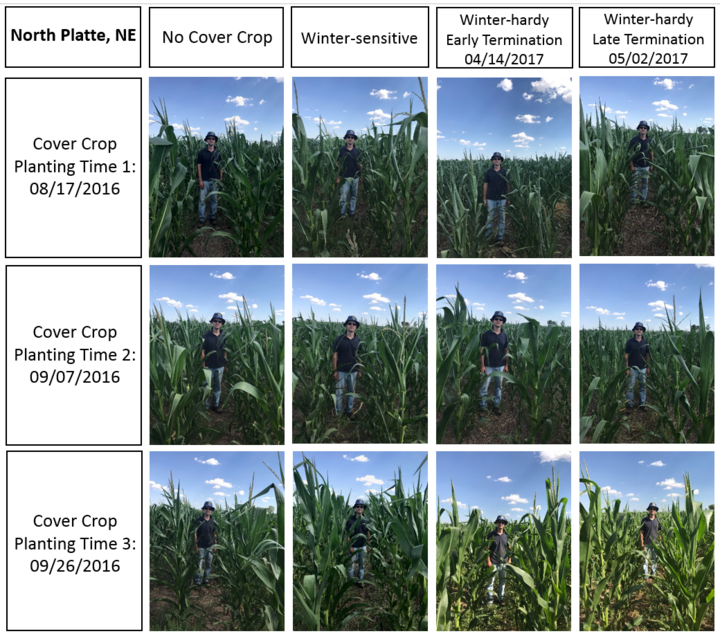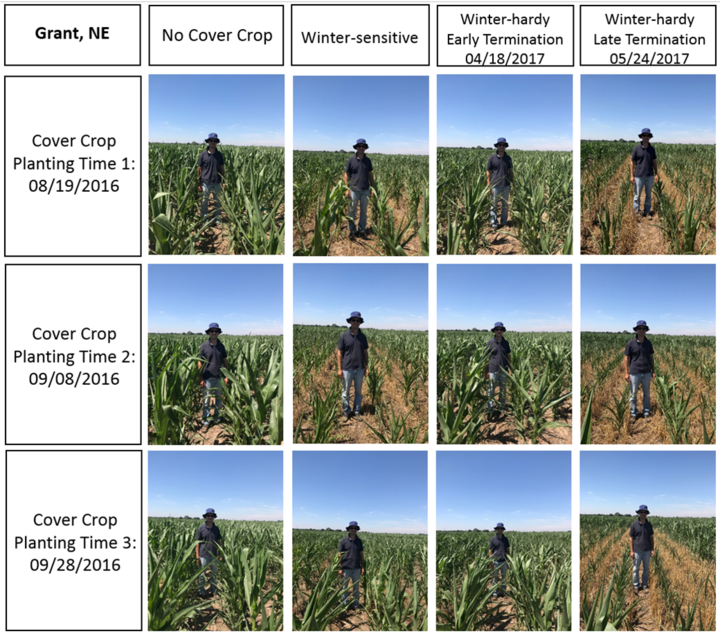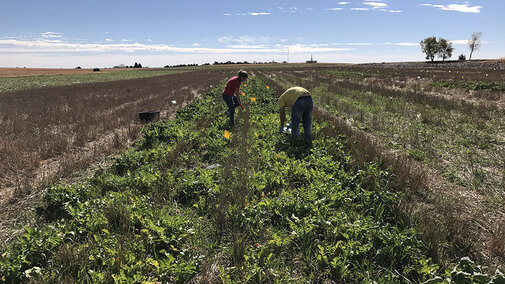Winter wheat and corn are often grown in a wheat-corn-fallow (WCF) rotation across rainfed production areas of western Nebraska and much of the semiarid Great Plains. In WCF systems, wheat is typically planted in September after a 10-month fallow period following corn harvest. Wheat is then harvested in June/July and followed by a second fallow period until corn planting the following April/May. Thus, two crops are harvested in a three-year period (Figure 1). Proper water storage during fallow periods is crucial for the success of this system. No-tillage, proper crop residue management, and weed management are key to the success of WCF. (For more information see Ecofarming: Spring Row Crop Planting and Weed Control in Winter Wheat Stubble.)

Cover crops are becoming popular across Nebraska and much of the Corn Belt. Producers in western Nebraska are interested in knowing whether and/or how cover crops should be incorporated into their cropping systems. Cover crops have the potential to reduce soil erosion and compaction, increase water holding capacity and soil organic matter, and suppress some pests. (See the NebGuide, Cover Crops: A Primer.) One of the major concerns regarding the inclusion of cover crops in the WCF rotation is the amount of water used by these “non-cash” species and potential yield reduction of the subsequent crop. In 2016, we were awarded the ARD Innovation Fund grant for Wheat/Cereal Crops from the University of Nebraska-Lincoln Institute of Agriculture and Natural Resources, allowing us to initiate a series of studies looking at the impact of wheat stubble management and cover crops planted after wheat harvest on subsequent corn productivity (Figure 2).

In one of the projects, initiated last year after wheat harvest at North Platte and Grant, the objective is to evaluate the impact of cover crops planting and termination time on fall and spring biomass production as well as the impact of cover crops on soil fertility and biological activity, and subsequent corn development and yield. Treatments consist of cover crop planting date (approximately three, six, and nine weeks after wheat harvest) and mixtures:
- winter-sensitive mix (black oats, spring barley, spring lentil, and daikon radish)
- winter-hardy mix (winter barley, winter triticale, hairy vetch, and daikon radish) terminated two to three weeks before corn planting
- winter-hardy mix terminated at or after corn planting, and
- no cover crops
Cover crop biomass was collected in fall 2016 after the first frost and in spring 2017. The winter-hardy mix was terminated in the spring with glyphosate. Corn was planted on May 5, 2017 at North Platte and on May 16, 2017 at Grant. Moisture readings are being collected at several depths every two weeks throughout the growing season. Additional measurements such as corn biomass and height, weed counts and biomass, residue biomass, soil samples for fertility and biological activity, and soil compaction are being collected. Yield data will be collected at the end of the season. Results from the first year of the study will be shared with clientele during our winter extension meetings. The study will be replicated during 2017/2018 at North Platte and Grant.
Preliminary Findings
- The earliest planting time resulted in the highest cover crop biomass production in the fall (Figures 3 and 4). At North Platte, radishes were the predominant species growing in the fall (data not shown), whereas the cool season grasses were the predominant species growing at Grant (likely due to dry conditions and possible herbicide carryover, which inhibited radish growth; data not shown).
- Only the winter-hardy mixture survived winter and produced biomass in the spring. At both sites the predominant species in spring were winter barley and winter triticale.
- The early-spring termination treatment prevented cover crops from producing significant amounts of biomass (
- For the late-spring termination, the two later planting times in the fall resulted in higher cover crop biomass for both sites.
- Not much growth was observed from the legumes in the mixtures (spring lentil and hairy vetch).
- Therefore, if producers want to optimize cover crop biomass production in the fall, cover crops should be planted shortly after wheat harvest. If producers aim to produce cover crop biomass mainly in the spring, they have a wider window to plant after wheat harvest.
 Figure 3. Cover crop biomass accumulation in the fall (A), early-spring (B), and late-spring (C), according to different planting times at North Platte.
Figure 3. Cover crop biomass accumulation in the fall (A), early-spring (B), and late-spring (C), according to different planting times at North Platte.
 Figure 4. Cover crop biomass accumulation in the fall (A), early-spring (B), and late-spring (C) according to different planting times at Grant.
Figure 4. Cover crop biomass accumulation in the fall (A), early-spring (B), and late-spring (C) according to different planting times at Grant.


In terms of corn growth and development, plants are more uniform at North Platte (Figure 5) when compared to Grant (Figure 6). At Grant, the late termination of cover crops occurred eight days after corn planting, which significantly delayed corn development (late termination occurred three days before corn planting at North Platte). This is likely due to excessive water use and nitrogen immobilization by late-terminated cover crops. According to the NRCS Cover Crop Termination Guidelines (and related CW article) for non-irrigated cropland, cover crops should be terminated at least 15 days before planting in central and western Nebraska.


Considerations
- Excessive cover crop growth before corn establishment, especially during dry years, will likely reduce yield potential of the corn.
- Winter-sensitive cover crop mixes should die in the winter; winter-hardy cover crop mixes will have to be terminated with herbicides and/or tillage in the spring.
- When planting cover crops in winter wheat production areas, it’s recommended that producers control volunteer wheat prior to cover crop establishment and select species that are not susceptible hosts to wheat streak mosaic virus. (See Managing Wheat Streak Mosaic.)
Additional projects looking at species selection and the impact of wheat stubble cutting height in combination with cover crops are being conducted across central, west central, and the Panhandle of Nebraska in collaboration with UNL specialists and educators. Results from these projects will help elaborate our recommendations for cover crop species selection and termination under rainfed cropping systems of semiarid Nebraska and beyond.
Acknowledgements
We would like to thank Liberty Butts, WCREC cropping systems research technologist, and the undergraduate and graduate students in our lab for their assistance with this project.

